
Nephila is a genus of araneomorph spiders noted for the impressive webs they weave. Nephila consists of numerous species found in warmer regions around the world, although some species formerly included in the genus have been moved to Trichonephila. They are commonly called golden silk orb-weavers, golden orb-weavers, giant wood spiders, or banana spiders.
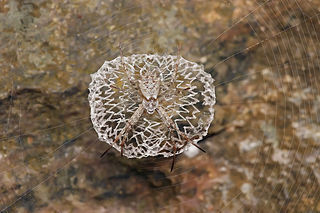
A stabilimentum, also known as a web decoration, is a conspicuous silk structure included in the webs of some species of orb-web spider. Its function is a subject of debate.

Trichonephila clavipes, commonly known as the golden silk orb-weaver, golden silk spider, or colloquially banana spider, is an orb-weaving spider species which inhabits forests and wooded areas ranging from the southern US to Argentina. It is indigenous to both continental North and South America. Known for the golden color of their silk, the large size of their females, and their distinctive red-brown and yellow coloring, T. clavipes construct large, asymmetrical circular webs attached to trees and low shrubs in woods to catch small- and medium-size flying prey, mostly insects. They are excellent web-builders, producing and utilizing seven different types of silk, and they subdue their prey by injecting them with venom, as opposed to related species which immobilize their prey by wrapping them in silk first. They are not known to be aggressive towards humans, only biting out of self-defense if touched, and their relatively harmless venom has a low toxicity, posing little health concern to healthy human adults. Due to their prevalence in forests, T. clavipes may be encountered by hikers.

Argiope keyserlingi is a species of orb-web spider found on the east coast of Australia, from Victoria to northern Queensland. It is very similar in appearance to a closely related north Queensland species, Argiope aetherea. A. keyserlingi is commonly found in large populations in suburban parks and gardens, particularly among the leaves of Lomandra longifolia. Like many species of orb-web spider, A. keyserlingi shows considerable sexual dimorphism, as the females are many times larger than the males. Mature females can be seen during the summer, and seeing multiple males on the web of one female is not uncommon.

Zygiella x-notata, sometimes known as the missing sector orb weaver or the silver-sided sector spider, is a spider species in the family Araneidae. They are solitary spiders, residing in daily-spun orb webs. Z. x-notata is a member of the genus Zygiella, the orb-weaving spiders. The adult female is easily recognized by the characteristic leaf-like mark on her posterior opisthosoma, caudal to the yellow-brown cephalothorax.
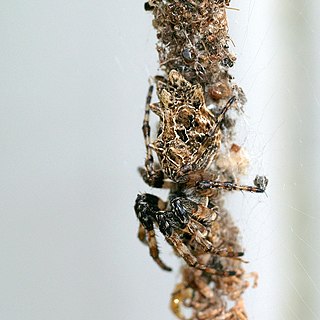
Cyclosa, also called trashline orbweavers, is a genus of orb-weaver spiders first described by Anton Menge in 1866. Widely distributed worldwide, spiders of the genus Cyclosa build relatively small orb webs with a web decoration. The web decoration in Cyclosa spiders is often linear and includes prey remains and other debris, which probably serve to camouflage the spider. The name "Cyclosa" comes from Greek 'to move in a circle', referring to how it spins its web.

Argiope argentata, commonly known as the silver argiope or silver garden spider due to the silvery color of its cephalothorax, is a member of the orb-weaver spider family Araneidae. This species resides in arid and warm environments in North America, Central America, the Caribbean and widely across South America. In the United States, it is found at least in Southern California, Florida, Arizona, and Texas. A. argentata create stabilimenta and a unique zig-zag in its web design, and it utilizes its UV-reflecting silk to attract pollinating species to prey upon. Like other species of Argiope, its venom is not harmful to humans; however, it can be employed to immobilize its prey. A. argentata engages in sexual cannibalism either mid- or post-copulation. One aspect of particular interest regarding this species is its extinction patterns, which notably have minimal correlation with its population size but rather occur sporadically for the species.
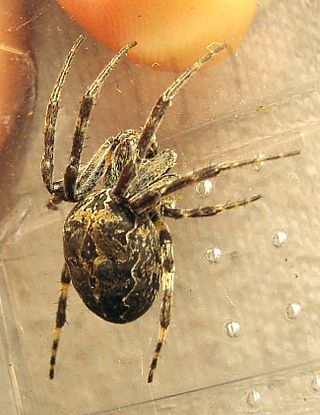
Larinioides sclopetarius, commonly called bridge-spider or gray cross-spider, is a relatively large orb-weaver spider with Holarctic distribution. These spiders originated in Europe, have been observed as south as the Mediterranean Coast and as north as Finland, and have been introduced to North America. They are often found on bridges, especially near light and over water. The species tends to live on steel objects and is seldom seen on vegetation. Females reach a body length of 10–14mm, and males 8–9mm. Their orb webs can have diameters of up to 70 cm.
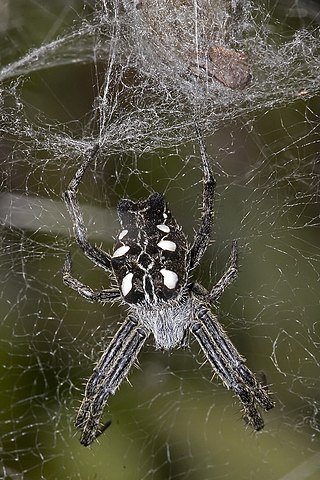
Cyrtophora citricola, also known as the tropical tent-web spider, is an orb-weaver spider in the family Araneidae. It is found in Asia, Africa, Australia, Costa Rica, Hispaniola, Colombia, and Southern Europe and in 2000, it was discovered in Florida. C. citricola differs from many of its close relatives due its ability to live in a wide variety of environments. In North America and South America, the spider has caused extensive damage to agricultural operations.

Spiders are air-breathing arthropods that have eight legs, chelicerae with fangs generally able to inject venom, and spinnerets that extrude silk. They are the largest order of arachnids and rank seventh in total species diversity among all orders of organisms. Spiders are found worldwide on every continent except for Antarctica, and have become established in nearly every land habitat. As of August 2022, 50,356 spider species in 132 families have been recorded by taxonomists. However, there has been debate among scientists about how families should be classified, with over 20 different classifications proposed since 1900.

Darwin's bark spider is an orb-weaver spider that produces the largest known orb webs, ranging from 900 to 28,000 square centimetres, with bridge lines spanning up to 25 metres (82 ft). The spider was discovered in Madagascar in the Andasibe-Mantadia National Park in 2009. Its silk is the toughest biological material ever studied. Its tensile strength is 1.6 GPa. The species was named in honour of the naturalist Charles Darwin on November 24, 2009—precisely 150 years after the publication of The Origin of Species.
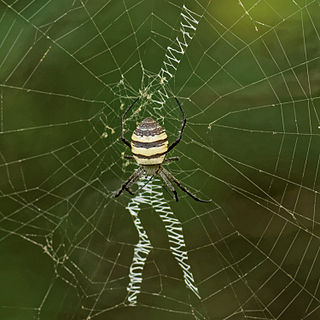
Argiope aemula, commonly known as the oval St Andrew's cross spider, is a species of spider in the family Araneidae which is native to southeast Asia, found from India and Sri Lanka to the Philippines, Indonesia, and Vanuatu. It is one of the giant, conspicuous "signature spider" species of the genus Argiope, observed in tropical and subtropical grasslands.
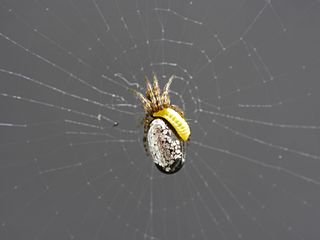
Reclinervellus nielseni is one of the spider-ectoparasitoids belonging to the Polysphincta genus-group and utilizes exclusively Cyclosa spiders as hosts. The species is distributed from Britain to Japan but is rather sparse. Host spider species is different in accordance with the region, that is Cyclosa conica in Europe whereas Cyclosa argenteoalba in Japan.

Tetragnatha montana, commonly known as the silver stretch spider, is a species of long-jawed orb weaver from the family Tetragnathidae that has a Palearctic distribution. It preys mostly on flies and mosquitoes. The name silver stretch spider refers to its shiny metallic colour and its habit of extending its legs into a stick like shape.
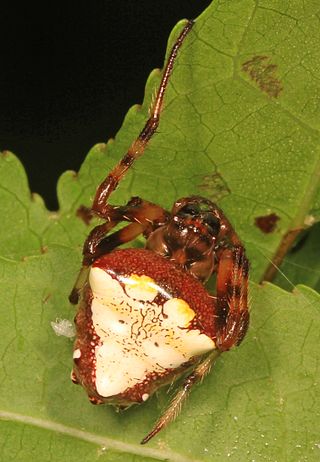
Verrucosa arenata, also known as the triangle orb weaver, arrowhead spider, and arrowhead orbweaver, is a species of orb-weaver spider found across North America. It is one of the few known large orb-weaver spiders that sits facing upwards in its web. Unlike most orb-weavers, which have bulbous abdomens, V. arenata has an abdomen that is pointy and triangular, shaped like the tip of an arrow. In females, the abdomen is colored white or yellow. Additionally, V. arenata uses reeling behavior in order to capture its prey, as its webs are stronger than that of most other orb weavers. The genus name Verrucosa means "warty" in Latin, referring to the small wartlike bumps on the spider's abdomen, while the specific epithet arenata derives from Latin arena, meaning "sand".
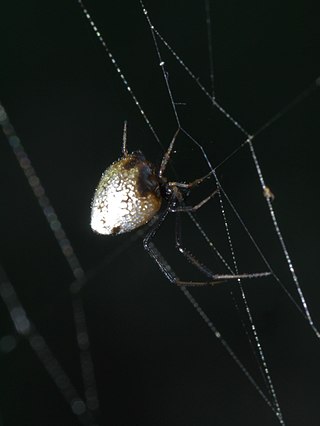
Argyrodes elevatus, commonly referred to as dew-drop spider, is part of the family Theridiidae that consists of more than 3,000 species. These spiders are most commonly found in subtropical and tropical regions in South and Central America, as well as southern regions of the United States. One of the key distinguishing characteristics of A. elevatus is its kleptoparasitic behavior through which it primarily procures food for survival. Typically 1 or 2 A. elevatus spiders preside in outer areas of webs built by other species of spiders, although it is possible for up to 45 spiders. There are two main mechanisms by which A. elevatus raid the hub of the host's web to steal insects preyed and wrapped by the host spider. A. elevatus follows an intricate course to the hub of the web to search for prey, using vibrational detection enhanced by laid out threads along the web to find and capture the insect. These spiders are highly efficient, with the theft lasting a maximum of 12 seconds and high success rates. This reliance on a host spider for food has led to adaptations in sleep schedules and alternate food sources to revolve around the host species activity. A. elevatus display a unique courtship routine in which male A. elevatus presents prey wrapped in silk as a nuptial gift to the female spider. The male spider approaches the female, carrying the nuptial gift on its chelicerae while communicating with a distinct courting vibration, followed by copulation. Approximately twenty-four hours after the A. elevatus courtship and copulation series of events, the female spider will lay one to two eggs on the outer regions of the host's web.

Cyclosa turbinata is a species of orb weaver belonging to the family of spiders known as Araneidae. It is found in a range from the United States to Panama, West Indies, Galapagos Islands, and has been introduced into Hawaii.
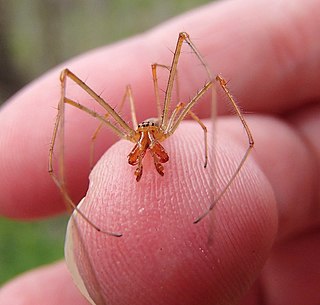
Tetragnatha versicolor is a species of long-jawed orb weaver in the spider family Tetragnathidae. It is found throughout North America, Canada, Central America, and Cuba, but are most common in the United States. T. versicolor is heavily concentrated in New England and the west coast in states like California and Washington. T. versicolor is considered a habitat generalist, and can thrive in many different environments. While they can be found in places like Grasslands, Wetlands, Forests, etc., they prefer dryer areas like normal trees and shrubs. Unlike other spiders in the genus Tetragnatha, T. versicolor will rarely reside near aquatic environments. T. versicolor will typically be colored dark yellow or pale orange and average around 5 mm for males and 6.5 mm for females in length, which is very small for a spider. They are much longer than they are wide, making them very distinct. In addition, T. versicolor can be distinguished from other spiders in Tetragnatha by the distinct separation of the anterior/posterior eyes and the appearance of their reproductive organs. As an orb weaver spider, T. versicolor creates a web to hunt for prey. It will wait at night for prey to stumble into its web and use vibrational signals throughout the web to sense trapped prey. In terms of mating behavior, T. versicolor lacks a distinct courting ritual and will mate with any others in the proximity. Mating behavior is heavily affected by female mating history. In terms of interactions with humans, the bite of T. versicolor is venomous, but not known to cause significant harm.

Leucauge mariana is a long-jawed orb weaver spider, native to Central America and South America. Its web building and sexual behavior have been studied extensively. Males perform several kinds of courtship behavior to induce females to copulate and to use their sperm.

Larinia jeskovi is a species of the family of orb weaver spiders and a part of the genus Larinia. It is distributed throughout the Americas, Africa, Australia, Europe, and Asia and commonly found in wet climes such as marshes, bogs, and rainforests. Larinia jeskovi have yellow bodies with stripes and range from 5.13 to 8.70 millimeters in body length. They build their webs on plants with a small height above small bodies of waters or wetlands. After sunset and before sunrise are the typical times they hunt and build their web. Males usually occupy a female's web instead of making their own. The mating behavior is noteworthy as male spiders often mutilate external female genitalia to reduce sperm competition while female spiders resort to sexual cannibalism to counter such mechanisms. The males also follow an elaborate courtship ritual to attract the female. The bite of Larinia jeskovi is not known to be of harm to humans.






















